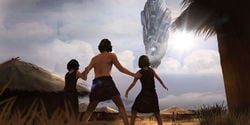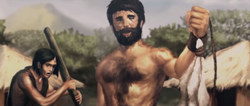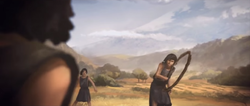Erde-Tyrene civilization: Difference between revisions
From Halopedia, the Halo wiki
m (Text replacement - "<ref name="([^"=>]+)" ?\/>" to "{{Ref/Reuse|$1}}") |
Sith Venator (talk | contribs) |
||
| (8 intermediate revisions by 6 users not shown) | |||
| Line 1: | Line 1: | ||
{{ | {{Status|Canon}}{{Status|Featured}} | ||
{{disambig header|the ancient humans regressed to hunter-gatherers|the original ancient humans with an advanced civilization|Ancestors}} | |||
[[File:H4Terminals - Humans.png|thumb|300px|The civilization on [[Omega Halo]].]] | [[File:H4Terminals - Humans.png|thumb|300px|The civilization on [[Omega Halo]].]] | ||
{{Quote|multi=more|Ur-Didact|q1=The [[human]]s' [[human-Forerunner wars|actions]] threatened the galaxy, yet we have treated them as the [[Mantle]] requires. Their punishment was just.|Librarian|q2=Justice is reducing their genetics in such short generations from a [[Prehistoric human civilization|space-faring race]] to... this?|Ur-Didact|q3=They are closer now to the animals they behaved as.|A conversation between the [[Ur-Didact]] and [[Librarian]]<ref>'''[[Halo 4]]''', ''[[Terminal (Halo 4)|Terminals]]''</ref>}} | {{Quote|multi=more|Ur-Didact|q1=The [[human]]s' [[human-Forerunner wars|actions]] threatened the galaxy, yet we have treated them as the [[Mantle]] requires. Their punishment was just.|Librarian|q2=Justice is reducing their genetics in such short generations from a [[Prehistoric human civilization|space-faring race]] to... this?|Ur-Didact|q3=They are closer now to the animals they behaved as.|A conversation between the [[Ur-Didact]] and [[Librarian]]<ref>'''[[Halo 4]]''', ''[[Terminal (Halo 4)|Terminals]]''</ref>}} | ||
| Line 13: | Line 14: | ||
===Regression and revival=== | ===Regression and revival=== | ||
[[File:H4-Terminal-Village.jpg|thumb | [[File:H4-Terminal-Village.jpg|thumb|250px|A village on [[Omega Halo]].]] | ||
As punishment for defying the Forerunners, the Forerunners' [[Ecumene Council|Old Council]] decreed that the humans be stripped of all technology and be forced to undergo an artificially-induced process of biological devolution: within a relatively short span of time, live humans had millions of years of their evolution reversed, soon leading to them losing body mass and, eventually, intelligence as well.<ref>'''Halo: Silentium''', ''page 42''</ref> This process was reluctantly overseen by the Forerunner [[Lifeshaper]], the [[Librarian]], acting under orders of the Old Council. While many Forerunners in positions of power wanted to see humanity wiped out, the Librarian spoke out in their defense, viewing them as special and potentially worthy of inheriting the Forerunners' [[Mantle|Mantle of Responsibility]].<ref>'''Halo: Cryptum''', ''page 77''</ref> | As punishment for defying the Forerunners, the Forerunners' [[Ecumene Council|Old Council]] decreed that the humans be stripped of all technology and be forced to undergo an artificially-induced process of biological devolution: within a relatively short span of time, live humans had millions of years of their evolution reversed, soon leading to them losing body mass and, eventually, intelligence as well.<ref>'''Halo: Silentium''', ''page 42''</ref> This process was reluctantly overseen by the Forerunner [[Lifeshaper]], the [[Librarian]], acting under orders of the Old Council. While many Forerunners in positions of power wanted to see humanity wiped out, the Librarian spoke out in their defense, viewing them as special and potentially worthy of inheriting the Forerunners' [[Mantle|Mantle of Responsibility]].<ref>'''Halo: Cryptum''', ''page 77''</ref> | ||
| Line 26: | Line 27: | ||
Regarding Earth her "special population", the Librarian would imprint the humans there with the [[Mind transfer|essences]] of human warriors processed via Composers after Charum Hakkor's fall. These imprints were kept dormant but were designed to awaken at the right triggers—such as those encountered by [[Chakas]] and [[Riser]] after meeting with the Forerunner [[IsoDidact|Bornstellar]]. However, both the Council and the Librarian forbade taking these humans to the Halos for preservation or storage, as not they did not want to risk the presence of ancient human military personnel on the weapons. Acting against their explicit instructions, the Master Builder took populations of imprinted Earth humans to Installation 07 in his feverish search for a cure for the Flood.<ref>'''Halo: Primordium''', ''page 189''</ref> | Regarding Earth her "special population", the Librarian would imprint the humans there with the [[Mind transfer|essences]] of human warriors processed via Composers after Charum Hakkor's fall. These imprints were kept dormant but were designed to awaken at the right triggers—such as those encountered by [[Chakas]] and [[Riser]] after meeting with the Forerunner [[IsoDidact|Bornstellar]]. However, both the Council and the Librarian forbade taking these humans to the Halos for preservation or storage, as not they did not want to risk the presence of ancient human military personnel on the weapons. Acting against their explicit instructions, the Master Builder took populations of imprinted Earth humans to Installation 07 in his feverish search for a cure for the Flood.<ref>'''Halo: Primordium''', ''page 189''</ref> | ||
[[File:ObservingArtifact.png|250px|thumb | [[File:ObservingArtifact.png|250px|thumb|The human civilization on Erde-Tyrene.]] | ||
Four years before the end of the [[Forerunner-Flood war]],<ref>'''Halo: Silentium''', ''page 197''</ref> the Librarian and her Lifeworkers initiated a mass evacuation of Erde-Tyrene, using their remote beacons to prompt all humans on the planet through their ''geas'' to cease their daily activities and gather in the Lifeworkers' evacuation ships.<ref>'''Halo: Silentium''', ''pages 17-18''</ref> Only several hundred scattered humans—most of them very old or young—were left on Earth after the evacuation.<ref name="s317">'''Halo: Silentium''', ''page 317''</ref> Due to the Lifeworkers' exceedingly limited resources and the need to store as many species as possible, many humans were not preserved intact but were reduced into biological composites which were taken to the greater Ark and retained in future generations of humans. Their physical remains would be used to provide nutrition for the microorganisms living in Earth's oceans between the sweep of the Halo pulse and Earth's repopulation.<ref>'''Halo: Silentium''', ''pages 56-57''</ref> The surviving specimens, held in stasis, were likewise transported to the greater Ark.<ref>'''Halo: Silentium''', ''page 26''</ref> Earth was sprayed with [[solute]], which would cause any organism affected by the Halo effect to instantly break down into its component molecules, preventing an ecological disaster from occurring.<ref>'''Halo: Silentium''', ''page 19''</ref> | Four years before the end of the [[Forerunner-Flood war]],<ref>'''Halo: Silentium''', ''page 197''</ref> the Librarian and her Lifeworkers initiated a mass evacuation of Erde-Tyrene, using their remote beacons to prompt all humans on the planet through their ''geas'' to cease their daily activities and gather in the Lifeworkers' evacuation ships.<ref>'''Halo: Silentium''', ''pages 17-18''</ref> Only several hundred scattered humans—most of them very old or young—were left on Earth after the evacuation.<ref name="s317">'''Halo: Silentium''', ''page 317''</ref> Due to the Lifeworkers' exceedingly limited resources and the need to store as many species as possible, many humans were not preserved intact but were reduced into biological composites which were taken to the greater Ark and retained in future generations of humans. Their physical remains would be used to provide nutrition for the microorganisms living in Earth's oceans between the sweep of the Halo pulse and Earth's repopulation.<ref>'''Halo: Silentium''', ''pages 56-57''</ref> The surviving specimens, held in stasis, were likewise transported to the greater Ark.<ref>'''Halo: Silentium''', ''page 26''</ref> Earth was sprayed with [[solute]], which would cause any organism affected by the Halo effect to instantly break down into its component molecules, preventing an ecological disaster from occurring.<ref>'''Halo: Silentium''', ''page 19''</ref> | ||
| Line 32: | Line 33: | ||
After the Forerunners moved their own surviving population to the greater Ark, the Librarian's indexed humans—who represented the bulk of the species—were moved to the nearby [[Omega Halo]]. Most of this population, as well as many of the formerly diverse human species, were lost when the [[Ur-Didact]] used the [[Composer]] on the inhabitants of Omega Halo. However, the Librarian and her successor, [[Chant-to-Green]], managed to save enough specimens aboard [[Installation 00]] to successfully revitalize ''Homo sapiens'' and several other species. Following the firing of the Halo Array, the surviving humans were [[reintroduction|returned]] to Earth.{{Ref/Reuse|rebirth}} | After the Forerunners moved their own surviving population to the greater Ark, the Librarian's indexed humans—who represented the bulk of the species—were moved to the nearby [[Omega Halo]]. Most of this population, as well as many of the formerly diverse human species, were lost when the [[Ur-Didact]] used the [[Composer]] on the inhabitants of Omega Halo. However, the Librarian and her successor, [[Chant-to-Green]], managed to save enough specimens aboard [[Installation 00]] to successfully revitalize ''Homo sapiens'' and several other species. Following the firing of the Halo Array, the surviving humans were [[reintroduction|returned]] to Earth.{{Ref/Reuse|rebirth}} | ||
After their reintroduction to Earth, the human civilization regressed once again, and would remain as Tier 7 hunter-gatherers for nearly a hundred millennia. The Librarian had imposed a ''[[geas]]'' upon the species, which has been said to have greatly affected their later development; in particular preparing humans for their role as [[Reclaimer|successors]] to the Forerunners as stewards of the galaxy.<ref>'''Halo: Primordium''', ''page 375''</ref>{{clear}} | After their reintroduction to Earth, the human civilization regressed once again, and would remain as Tier 7 hunter-gatherers for nearly a hundred millennia. The Librarian had imposed a ''[[geas]]'' upon the species, which has been said to have greatly affected their later development; in particular preparing humans for their role as [[Reclaimer|successors]] to the Forerunners as stewards of the galaxy.<ref>'''Halo: Primordium''', ''page 375''</ref> In [[2557]], while meeting with [[343 Guilty Spark]] - who had been the Erde-Tyrene human [[Chakas]] before becoming a Monitor - the Librarian told him that Spark's friends [[Riser]] and [[Vinnevra]], who were sent back to Earth as part of the reintroduction, were left to live out their lives in peace, their ''geas'' silent.{{Ref/Novel|Ren|48}} | ||
{{clear}} | |||
==Species== | ==Species== | ||
In this time period, Earth was home to numerous sapient species of [[Wikipedia:Homo|human]], [[Wikipedia:Hominidae|hominid]], [[Wikipedia:Ape|hominoid]], and [[Wikipedia:Simian|anthropoid]], all of whom were understood, or regarded themselves, as being part of a single "People".<ref name="p169">'''Halo: Primordium''', ''page 169''</ref> The multitude of species among the human genus itself was generated rather rapidly, most of them over | In this time period, Earth was home to numerous sapient species of [[Wikipedia:Homo|human]], [[Wikipedia:Hominidae|hominid]], [[Wikipedia:Ape|hominoid]], and [[Wikipedia:Simian|anthropoid]], all of whom were understood, or regarded themselves, as being part of a single "People".<ref name="p169">'''Halo: Primordium''', ''page 169''</ref> The multitude of species among the human genus itself was generated rather rapidly, most of them over only a thousand years, after the humans' forced devolution at the hands of the Forerunners. There were more than twenty species regarded as human,<ref name="c25">'''Halo: Cryptum''', ''pages 25-26''</ref> with over 120 different subtypes known.{{Ref/Reuse|p188}} These various forms represented species and subspecies both new and ones that had once existed but were suppressed throughout the devolution.<ref>'''Halo: Silentium''', ''page 48''</ref> While given human species had stayed remarkably similar to their ancestral forms during their regression and re-evolution in superficial terms,<ref>'''Halo: Primordium''', ''page 129''</ref> humans never fully recovered to the level of their ancient ancestors in terms of size, strength and intelligence.<ref name="wp hum">[https://www.halowaypoint.com/en-us/universe/species/humans '''Halo Waypoint''': ''Humans'']</ref> This meddling was noted to have considerably distorted Earth's natural fossil records,<ref name="c127">'''Halo: Cryptum''', ''page 127''</ref> and made it difficult to determine the exact lineage for a particular human species.<ref>'''Halo: Primordium''', ''page 242''</ref> | ||
Some, although not all, of these species were saved in the Lifeworkers' [[Conservation Measure]] and made it to [[Installation 00]] for preservation when the [[Halo Array]] was fired. In the endgame of the Flood war, the Librarian estimated that only four or five human species remained intact, and due to the scarcity of healthy and intact specimens the recovery of all of the genetic composites the Lifeworkers had stored may be impossible.{{Ref/Reuse|s317}} | Some, although not all, of these species were saved in the Lifeworkers' [[Conservation Measure]] and made it to [[Installation 00]] for preservation when the [[Halo Array]] was fired. In the endgame of the Flood war, the Librarian estimated that only four or five human species remained intact, and due to the scarcity of healthy and intact specimens the recovery of all of the genetic composites the Lifeworkers had stored may be impossible.{{Ref/Reuse|s317}} | ||
| Line 72: | Line 75: | ||
===Rituals=== | ===Rituals=== | ||
[[File:H4-Terminal-Village-Closeup.jpg|thumb|250px|The ''[[Mantle's Approach]]'' over a human village.]] | [[File:H4-Terminal-Village-Closeup.jpg|thumb|250px|The ''[[Mantle's Approach]]'' over a human village.]] | ||
Upon maturing, males in the greater Marontik area would traditionally undergo rite of passage which involved being led through a series of "sacred caves" located a day's journey from Marontik.<ref>'''Halo: Primordium''', ''page 206''</ref> These caves contained myriad paintings describing the humans' beliefs about life and death.<ref>'''Halo: Primordium''', ''page 221''</ref> During the ceremony, the caves would be fumed with the smoke of intoxicating leaves and with the initiate's body covered in clay, elder shamans would carve a series of ritual scarification designs to his back, shoulders, ribs and chest using bone knives.<ref>'''Halo: Primordium''', ''pages 53, 275''</ref> Those who had undergone the ritual would often repeat the mantra ''"for so I have seen in the sacred caves"'' to affirm their belief in what they had seen.<ref>'''Halo: Primordium''', ''page 16''</ref> | Upon maturing, males in the greater Marontik area would traditionally undergo a rite of passage which involved being led through a series of "sacred caves" located a day's journey from Marontik.<ref>'''Halo: Primordium''', ''page 206''</ref> These caves contained myriad paintings describing the humans' beliefs about life and death.<ref>'''Halo: Primordium''', ''page 221''</ref> During the ceremony, the caves would be fumed with the smoke of intoxicating leaves and with the initiate's body covered in clay, elder shamans would carve a series of ritual scarification designs to his back, shoulders, ribs and chest using bone knives.<ref>'''Halo: Primordium''', ''pages 53, 275''</ref> Those who had undergone the ritual would often repeat the mantra ''"for so I have seen in the sacred caves"'' to affirm their belief in what they had seen.<ref>'''Halo: Primordium''', ''page 16''</ref> | ||
A dying relative would be prepared for the afterlife through a farewell rite which involved the recitation of a prayer so the dying individual would safely pass over the "western waters" to the [[Far Shore]] and that the gods that await on the other side—[[Abada|Abada the Rhinoceros]] and the Great Elephant—would not reject them. It was feared that Abada and the Elephant might turn away if they smelled fear, or if the proper rites were not conducted. In that case, the individual would be left to hyenas and buzzards and would not be granted into a peaceful afterlife,<ref>'''Halo: Primordium''', ''pages 16, 54, 205-207, 219''</ref> instead being forced to roam the earth restlessly as a ghost.{{Ref/Reuse|rebirth}} According to some old stories, the dead would continue to walk forever without knowing where they were going.<ref>'''Halo: Primordium''', ''page 286''</ref> | A dying relative would be prepared for the afterlife through a farewell rite which involved the recitation of a prayer so the dying individual would safely pass over the "western waters" to the [[Far Shore]] and that the gods that await on the other side—[[Abada|Abada the Rhinoceros]] and the Great Elephant—would not reject them. It was feared that Abada and the Elephant might turn away if they smelled fear, or if the proper rites were not conducted. In that case, the individual would be left to hyenas and buzzards and would not be granted into a peaceful afterlife,<ref>'''Halo: Primordium''', ''pages 16, 54, 205-207, 219''</ref> instead being forced to roam the earth restlessly as a ghost.{{Ref/Reuse|rebirth}} According to some old stories, the dead would continue to walk forever without knowing where they were going.<ref>'''Halo: Primordium''', ''page 286''</ref> | ||
| Line 89: | Line 92: | ||
*According to one account of the creation of humans, ''Mongoose'', a god known for being a trickster, was said to have convinced Mud to mate with the Sun (both personified deities). This union resulted in the creation of worms, which the Mongoose angered and teased until they grew legs and chased it over the grasslands. The worms became humans, who would continue to be played jokes on by humorless gods of Tree, River, Rock and Cloud.<ref>'''Halo: Primordium''', ''pages 209-310''</ref> | *According to one account of the creation of humans, ''Mongoose'', a god known for being a trickster, was said to have convinced Mud to mate with the Sun (both personified deities). This union resulted in the creation of worms, which the Mongoose angered and teased until they grew legs and chased it over the grasslands. The worms became humans, who would continue to be played jokes on by humorless gods of Tree, River, Rock and Cloud.<ref>'''Halo: Primordium''', ''pages 209-310''</ref> | ||
*''[[Shalimanda]]'', the heaven-snake, was told to have swallowed an original, jewel-covered stream of worlds. It exploded the next night, bringing forth the Earth-like worlds | *''[[Shalimanda]]'', the heaven-snake, was told to have swallowed an original, jewel-covered stream of worlds. It exploded the next night, bringing forth the Earth-like worlds that gave birth to humans.{{Ref/Reuse|p210}} | ||
==Trivia== | ==Trivia== | ||
| Line 105: | Line 108: | ||
*''[[Halo Mythos]]'' | *''[[Halo Mythos]]'' | ||
*''[[Halo: Point of Light]]'' {{Mo}} | *''[[Halo: Point of Light]]'' {{Mo}} | ||
*''[[Halo: Epitaph]]'' | |||
*''[[Halo: The Machine Breaks]]'' {{Mo}} | |||
==Notes== | ==Notes== | ||
Latest revision as of 12:09, September 5, 2024
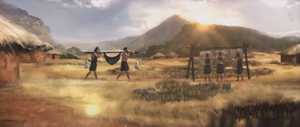
- Ur-Didact: "The humans' actions threatened the galaxy, yet we have treated them as the Mantle requires. Their punishment was just."
- Librarian: "Justice is reducing their genetics in such short generations from a space-faring race to... this?"
- Ur-Didact: "They are closer now to the animals they behaved as."
- — A conversation between the Ur-Didact and Librarian[1]
Between approximately 106,445 BCE and 97,445 BCE, a prehistoric civilization shared by various species and subspecies of human and related genera existed on Earth, then known as Erde-Tyrene.[Note 1] This civilization was a reduced remnant of humanity's previous interstellar empire, which was shattered by the Forerunners at the conclusion of the human-Forerunner wars. Erde-Tyrene itself was considered an insignificant and obscure vassal planet of the Forerunners' ecumene, with a Forerunner Miner presence on the nearby Mars, known as Edom at the time.[2]
History[edit]
Previous civilization[edit]
- Main article: Prehistoric human civilization
Humans first evolved and achieved civilization on Earth, originally known as Erda or Erde-Tyrene,[3] before 1,100,000 BCE. For over a million years,[4] humanity roamed the galaxy, experiencing a number of technological dark ages in the interim.[3] Around 107,445 BCE, their latest—and last—interstellar empire stumbled upon the parasitic Flood, which indirectly forced humanity into a millennium-long conflict with the Forerunners. Exhausted from fighting the Flood, the humans were eventually defeated.
Following humanity's surrender at their capital of Charum Hakkor and the end of the human-Forerunner wars, the Forerunners used Composers to extract the patterns of the remaining humans on Charum Hakkor. However, many more humans remained in scattered redoubts across the galaxy, which the Forerunners and their subject species proceeded to conquer and gather any live specimens.[5] These humans were transported back to Earth while all signs of human achievement and technology were erased from the galaxy.[6]
Regression and revival[edit]

As punishment for defying the Forerunners, the Forerunners' Old Council decreed that the humans be stripped of all technology and be forced to undergo an artificially-induced process of biological devolution: within a relatively short span of time, live humans had millions of years of their evolution reversed, soon leading to them losing body mass and, eventually, intelligence as well.[7] This process was reluctantly overseen by the Forerunner Lifeshaper, the Librarian, acting under orders of the Old Council. While many Forerunners in positions of power wanted to see humanity wiped out, the Librarian spoke out in their defense, viewing them as special and potentially worthy of inheriting the Forerunners' Mantle of Responsibility.[8]
The Librarian's beliefs about humanity were reinforced during the subsequent millennium: in only a thousand years, the devolved humans' population skyrocketed. Furthermore, the humans branched off into numerous species and subspecies, progress that should have normally taken millions of years. While this was partly due to the assistance of the Librarian and her geas, there were also unknown factors not even the Librarian and her subordinate Lifeworkers could explain despite studying the humans' genetic code in detail.[6] Over twenty of these species migrated across Earth and formed separate populations across the planet.[9]
The development of civilization began anew; humans began to settle down and gather into tribal communities and villages. They began to grow crops and domesticated many animals, such as sheep, goats, wolves, cattle, and birds. They developed tools and basic technology; this spurred the development of trade and even fledgling industry.[6][9][10] Others continued to live in Tier 7 tribal communities, such as the one that was encountered by the Forerunners during the construction of the portal to the Ark in eastern Africa.[11]
Conservation Measure[edit]
Humanity was one of many species indexed and preserved by the Librarian during the Lifeworkers' Conservation Measure, the effort to catalog and index all life in the ecumene for repopulation in the event the Halo Array was fired. With a primary population of specimens held at the greater Ark, another population of hundreds of thousands of humans of over 120 different varieties was ferried from Earth to Installation 07, where they were later exploited by Faber, the Master Builder, in a series of experiments on the Flood.[12]
Regarding Earth her "special population", the Librarian would imprint the humans there with the essences of human warriors processed via Composers after Charum Hakkor's fall. These imprints were kept dormant but were designed to awaken at the right triggers—such as those encountered by Chakas and Riser after meeting with the Forerunner Bornstellar. However, both the Council and the Librarian forbade taking these humans to the Halos for preservation or storage, as not they did not want to risk the presence of ancient human military personnel on the weapons. Acting against their explicit instructions, the Master Builder took populations of imprinted Earth humans to Installation 07 in his feverish search for a cure for the Flood.[13]
Four years before the end of the Forerunner-Flood war,[14] the Librarian and her Lifeworkers initiated a mass evacuation of Erde-Tyrene, using their remote beacons to prompt all humans on the planet through their geas to cease their daily activities and gather in the Lifeworkers' evacuation ships.[15] Only several hundred scattered humans—most of them very old or young—were left on Earth after the evacuation.[16] Due to the Lifeworkers' exceedingly limited resources and the need to store as many species as possible, many humans were not preserved intact but were reduced into biological composites which were taken to the greater Ark and retained in future generations of humans. Their physical remains would be used to provide nutrition for the microorganisms living in Earth's oceans between the sweep of the Halo pulse and Earth's repopulation.[17] The surviving specimens, held in stasis, were likewise transported to the greater Ark.[18] Earth was sprayed with solute, which would cause any organism affected by the Halo effect to instantly break down into its component molecules, preventing an ecological disaster from occurring.[19]
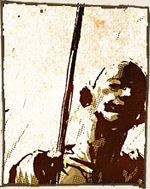
After the Forerunners moved their own surviving population to the greater Ark, the Librarian's indexed humans—who represented the bulk of the species—were moved to the nearby Omega Halo. Most of this population, as well as many of the formerly diverse human species, were lost when the Ur-Didact used the Composer on the inhabitants of Omega Halo. However, the Librarian and her successor, Chant-to-Green, managed to save enough specimens aboard Installation 00 to successfully revitalize Homo sapiens and several other species. Following the firing of the Halo Array, the surviving humans were returned to Earth.[20]
After their reintroduction to Earth, the human civilization regressed once again, and would remain as Tier 7 hunter-gatherers for nearly a hundred millennia. The Librarian had imposed a geas upon the species, which has been said to have greatly affected their later development; in particular preparing humans for their role as successors to the Forerunners as stewards of the galaxy.[21] In 2557, while meeting with 343 Guilty Spark - who had been the Erde-Tyrene human Chakas before becoming a Monitor - the Librarian told him that Spark's friends Riser and Vinnevra, who were sent back to Earth as part of the reintroduction, were left to live out their lives in peace, their geas silent.[22]
Species[edit]
In this time period, Earth was home to numerous sapient species of human, hominid, hominoid, and anthropoid, all of whom were understood, or regarded themselves, as being part of a single "People".[23] The multitude of species among the human genus itself was generated rather rapidly, most of them over only a thousand years, after the humans' forced devolution at the hands of the Forerunners. There were more than twenty species regarded as human,[9] with over 120 different subtypes known.[12] These various forms represented species and subspecies both new and ones that had once existed but were suppressed throughout the devolution.[24] While given human species had stayed remarkably similar to their ancestral forms during their regression and re-evolution in superficial terms,[25] humans never fully recovered to the level of their ancient ancestors in terms of size, strength and intelligence.[26] This meddling was noted to have considerably distorted Earth's natural fossil records,[27] and made it difficult to determine the exact lineage for a particular human species.[28]
Some, although not all, of these species were saved in the Lifeworkers' Conservation Measure and made it to Installation 00 for preservation when the Halo Array was fired. In the endgame of the Flood war, the Librarian estimated that only four or five human species remained intact, and due to the scarcity of healthy and intact specimens the recovery of all of the genetic composites the Lifeworkers had stored may be impossible.[16]
- Hamanush (Homo sapiens; modern human): among the most prominent species; would several tens of thousands of years later supersede all of the others as the sole human species
- Chamanush (Homo floresiensis; Florian): a diminutive species later transplanted to Flores and several nearby islands; long-lived, hirsute and expressive-faced
- K'tamanush (Homo neanderthalensis; Neanderthal): roamed the northern ice flats of Earth,[9] which was undergoing a glacial period at the time[29]
- B'ashamanush: a thin and lithe species which inhabited Earth's equatorial grasslands[9]
- Denisovan: close relatives to both Homo sapiens and neanderthalensis; tall and lean in stature[23]
- Shakyanunsho (Gigantopitechus): a sapient species of giant orangutan that lived in highlands north of Marontik[30]
The names of these species were changed to reflect significant changes: when most members of a given species were dead or away from a major spiritual center, the species' name would be prefixed with a glottal click. These rules were known to all humans across Erde-Tyrene but were kept secret from non-human species such as the Forerunners.[20]
Notable individuals[edit]
Culture and technology[edit]
Upon humanity's defeat, the Forerunners restricted the humans' access to all forms of technology, regressing them back to a hunter-gatherer state. Still, as Erde-Tyrene gradually faded into obscurity in the eyes of the Old Council and the Builders, the Librarian encouraged the humans to begin redeveloping civilization and technology.[6] By the final years before the Halos' activation, rudimentary cities were in evidence, most notable of them being Marontik, located amidst a region of expansive grasslands. By that time, humans had also developed primitive industry,[6] hot-air balloons and steam-powered waterborne vessels as a relatively recent invention.[31] This led to a strange hodgepodge of the humans' relatively primitive tribal culture and tradition mixed in with these comparatively sophisticated technologies.[32] As one other curious feature of note, certain customs and traditions were shared across all humans on Erde-Tyrene,[20] a trait typically unheard of with civilizations of this technological level.
In the human society of this time, it was common for women to marry and bear children relatively early.[33] Humans in warm regions—such as Marontik—typically wore assorted rags and loincloths, although more developed pieces of clothing, including pants and shirts, were worn as well.[34]
Religion and mythology[edit]
The humans of this civilization followed the way of daowa-maad, the basis of which had survived humanity's devolution from their prior, advanced civilization.[35] Their most sacred beliefs regarding life and death as well as the power of names were tied to this concept.[36][37] In addition, they worshiped the Librarian as "the Lifeshaper" or "the Lady",[38] viewing her as a sort of goddess who personally visited humans at birth and gave them a purpose.[39] This belief had a basis in truth; the Librarian did subconsciously appear to newborns via a remote imprinting system to give them her geas.[40] This faith was practiced in dedicated temples, one of which was located in Marontik.[41]
Names were considered highly important,[37] with an individual's "true name" known only to themselves and their closest relatives while most would refer to him or her by a "borrowing name".[42]
Rituals[edit]
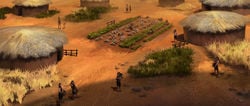
Upon maturing, males in the greater Marontik area would traditionally undergo a rite of passage which involved being led through a series of "sacred caves" located a day's journey from Marontik.[43] These caves contained myriad paintings describing the humans' beliefs about life and death.[44] During the ceremony, the caves would be fumed with the smoke of intoxicating leaves and with the initiate's body covered in clay, elder shamans would carve a series of ritual scarification designs to his back, shoulders, ribs and chest using bone knives.[45] Those who had undergone the ritual would often repeat the mantra "for so I have seen in the sacred caves" to affirm their belief in what they had seen.[46]
A dying relative would be prepared for the afterlife through a farewell rite which involved the recitation of a prayer so the dying individual would safely pass over the "western waters" to the Far Shore and that the gods that await on the other side—Abada the Rhinoceros and the Great Elephant—would not reject them. It was feared that Abada and the Elephant might turn away if they smelled fear, or if the proper rites were not conducted. In that case, the individual would be left to hyenas and buzzards and would not be granted into a peaceful afterlife,[47] instead being forced to roam the earth restlessly as a ghost.[20] According to some old stories, the dead would continue to walk forever without knowing where they were going.[48]
Myths[edit]
In addition to their primary beliefs about afterlife, the humans of Erde-Tyrene had a rich oral tradition of legends and myths, many of them mutually contradictory and liberally mixed in with their religion. These featured a broad pantheon of deities, many of them embodied in animal form.[49] Their worldview was generally animistic and featured a plethora of various secondary gods, spirits and ghosts. These incorporeal beings were generally considered unpredictable, occasionally mischievous, and judgmental of the living, because of the lust and envy they felt for them.[50] There were many tales of gods and devils which played tricks on humans, commonly told to children.[51]
- The First Human or First Man was a mythical figure who had a forefinger the size of a tree which held the souls of all his children; the human generations to come.[52] Chakas, after being converted into a monitor with the essences of thousands of ancient humans stored within compared himself to this being.[53]
- The Vaeites and Alben were entities who were said to appear in the humans' oldest dreams. Riser once compared the Forerunners to these beings.[54]
- A warning tale about story devils described a being who traveled across the land and told great stories; however, those who listened became mute and their descendants would only talk babble. Upon Chakas telling Vinnevra this story, she asked him if the Primordial was a story devil.[55]
- In a particular story, the sky was told to be a great flat plane on which glowing insects moved and occasionally, someone opened a door to let in light from the outside. The stars were also told to be holes punched in the sky by birds pecking for insects.[56]
- According to one account of the creation of humans, Mongoose, a god known for being a trickster, was said to have convinced Mud to mate with the Sun (both personified deities). This union resulted in the creation of worms, which the Mongoose angered and teased until they grew legs and chased it over the grasslands. The worms became humans, who would continue to be played jokes on by humorless gods of Tree, River, Rock and Cloud.[57]
- Shalimanda, the heaven-snake, was told to have swallowed an original, jewel-covered stream of worlds. It exploded the next night, bringing forth the Earth-like worlds that gave birth to humans.[37]
Trivia[edit]
The common term for the different human species, "manush", was derived from the Romani language, in which manush is the word for "human being" or "man". The word itself is one of many derivatives of the Sanskrit word manusia, among the Indo-Aryan languages.
List of appearances[edit]
- Halo 3
- Terminals (Indirect mention)
- Halo: Cryptum (First appearance)
- Halo: Primordium
- Halo 4
- Halo: Silentium
- Rebirth
- Halo Mythos
- Halo: Point of Light (Mentioned only)
- Halo: Epitaph
- Halo: The Machine Breaks (Mentioned only)
Notes[edit]
- ^ Although the narrative of The Forerunner Saga mainly concerns humans from Marontik and its immediate region, Riser mentions in Rebirth that "Any human on Erde-Tyrene would have known how to voice respect for those now gone"; as such, it is assumed that the same civilization spanned the entire planet at least on a certain level.
Sources[edit]
- ^ Halo 4, Terminals
- ^ Halo: Cryptum, pages 15, 17
- ^ a b Halo: Primordium, page 237-238
- ^ Halo: Silentium, pages 67-68
- ^ Halo: Primordium, page 156
- ^ a b c d e Halo: Silentium, pages 45-47
- ^ Halo: Silentium, page 42
- ^ Halo: Cryptum, page 77
- ^ a b c d e Halo: Cryptum, pages 25-26
- ^ Halo: Cryptum, page 86
- ^ Halo 3: The Cradle of Life
- ^ a b Halo: Primordium, page 188
- ^ Halo: Primordium, page 189
- ^ Halo: Silentium, page 197
- ^ Halo: Silentium, pages 17-18
- ^ a b Halo: Silentium, page 317
- ^ Halo: Silentium, pages 56-57
- ^ Halo: Silentium, page 26
- ^ Halo: Silentium, page 19
- ^ a b c d Rebirth
- ^ Halo: Primordium, page 375
- ^ Halo: Renegades, chapter 48
- ^ a b Halo: Primordium, page 169
- ^ Halo: Silentium, page 48
- ^ Halo: Primordium, page 129
- ^ Halo Waypoint: Humans
- ^ Halo: Cryptum, page 127
- ^ Halo: Primordium, page 242
- ^ Halo: Cryptum, page 20
- ^ Halo: Primordium, pages 145-146, 186, 212
- ^ Halo: Primordium, page 59
- ^ Halo: Cryptum, pages 21-22
- ^ Halo: Primordium, page 44
- ^ Halo: Primordium, pages 48, 121
- ^ Halo: Primordium, pages 55-56
- ^ Halo: Primordium, page 207
- ^ a b c Halo: Primordium, page 210
- ^ Halo: Primordium, page 48
- ^ Halo: Cryptum, page 46
- ^ Halo: Primordium, page 374
- ^ Halo: Primordium, page 30
- ^ Halo: Primordium, page 42
- ^ Halo: Primordium, page 206
- ^ Halo: Primordium, page 221
- ^ Halo: Primordium, pages 53, 275
- ^ Halo: Primordium, page 16
- ^ Halo: Primordium, pages 16, 54, 205-207, 219
- ^ Halo: Primordium, page 286
- ^ Halo: Primordium, page 182
- ^ Halo: Primordium, page 54
- ^ Halo: Primordium, pages 284-285
- ^ Halo: Primordium, page 204
- ^ Halo: Primordium, page 371
- ^ Halo: Primordium, page 34
- ^ Halo: Primordium, pages 220-221
- ^ Halo: Primordium, page 279
- ^ Halo: Primordium, pages 209-310
